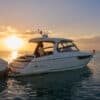Learn how to stay safe while enjoying your favorite water sports with this guide.
Part of loving the boating lifestyle is having access to many fun and thrilling water sports. This is the reason many families decide a boat is the perfect purchase. They can enjoy water sports and excel at numerous different water sports.
Water sports are supposed to be fun for everyone involved. The person participating, anyone on board, and the captain should be enjoying their time on the water. To make sure everyone is having a good time on the water, safety should be the top priority.
In this article and video, we will review how to stay safe while participating in water sports. There are several aspects to staying safe as everyone plays a role, which is why we’re here to help.
The Boat
To start, we’ll review how the boat should be set up for water sports. There are many different types of boats on the market today. Each boat is set up differently for driving and for water sports. Let’s dig into setting the boat up for the water.
Is the Boat Built for Water Sports?
Some boats are specialized for water sports whereas others are built more for cruising or entertainment. Boats that are built specifically for water sports are typically inboards. However, some sterndrives are also built specifically for water sports now.
Other boats such as outboards are not typically built for water sports. This doesn’t mean you can’t do water sports, however, you only need to take an extra step of safety to make sure everyone is safe. With outboards and standard sterndrives, you are only able to do longline sports such as water skiing, wakeboarding, tubing, and foiling. You are not able to surf since the propeller is so close to where the rider would be, it would be extremely dangerous.
Rope Attachment
Depending on what kind of boat you have, the spot you attach your rope to may vary. Some boats have towers with a rope attachment at the top. Others have a popup ski pylon towards the stern of the back. And some have a ski tow bar at the back. Make sure to find the proper attachment point on your boat before heading out for a day on the water.
The Captain’s Duty
As the driver of the boat, most of the responsibility for safety falls into the captain’s hands. The captain must put safety above all else while on the water. And even more importantly, while towing someone participating in a water sport.
Let’s discuss the specifics of how to drive with water sports.
Driving for Water Sports
Each sport requires a different way to drive the boat. For example, you won’t drive the same for someone tubing as you will with someone surfing behind the boat. Each sport requires a different speed, straightness, and ways to take a corner.
Water Skiing
Water skiing is a very fast-paced sport that requires a driver who feels confident pulling someone from 25-40 MPH. Since you want the smallest wake possible, you need to also drive your boat in a straight line. Turning unexpectedly could cause your rider to fall and potentially get injured.
Wakeboarding
Another fast-paced water sport is wakeboarding. Though fast, you’ll be driving slower between 20-25 MPH. This allows the boat to create a bigger wake for the rider to try tricks. Similar to water skiing, it’s important to drive in a straight line while towing a wakeboarder.
Wake Surfing
Wake surfing is one of the most popular water sports today. Driving a wake surfer is quite different than wakeboarding or water skiing. This sport only needs speeds ranging from 8-12 MPH. It is significantly slower to create a wave that can push a surfer along.
Another difference is that driving in a straight line isn’t necessary for wake surfing. It is important to make sure that you are surfing in deep water so you don’t cause damage to your boat.
Wake Foiling
This water sport is gaining a lot of popularity so it’s important to know how to properly drive for this sport. Typically, speeds for this sport are similar to wake surfing with a variation of 1 MPH or so. Foiling requires a similar drive style as wake surfing which makes it easy for the captain. For beginners, make sure to pull them out of the water very slowly to allow them to get comfortable on the foil.
Tubing
This water sport is an outlier from the others as its main goal is to throw riders from the tube. Since this sport requires a somewhat chaotic driving technique, it’s important to always know your surroundings. When turning and doing donuts, always make sure you don’t turn too tight and there are no boats in the vicinity.
It’s also important to know the level of the riders. Some riders prefer to cruise around the lake and others prefer to be challenged. Check with your riders before jumping behind the wheel with some tubers.
Picking Up a Rider
Now that you know how to drive for each water sport, it’s crucial that you also know how to pick up a fallen rider. Depending on weather, it can be stressful to pick someone up in the water. For that reason, safety should always be the first priority.
One duty of the rider is to stay put. Don’t try to swim to the boat as it makes it that much harder for the captain to gauge how far away from the swimmer to stay. As for the captain, follow these steps to safely pick up a rider:
Step 1: Slow down when the rider falls
Right when the rider falls, pull the boat back into neutral. Never try to power turn around because you will end up swamping the front of the boat and putting other boaters in danger.
Step 2: Slowly idle to turn around
By idling while turning around, you will avoid any big waves your boat may have caused. This way you don’t have to worry about bouncing over waves or swamping the bow of the boat.
Step 3: Approach the rider on the captain’s side
As the captain, you will want to make sure that the rider is always visible. Approach the rider slowly and make sure there is plenty of room between the boat and the rider. This will ensure the safety of the rider while in the water.
The Rider’s Duty
Now that the captain is equipped with the correct information to keep the rider safe, there are a few duties that the rider is responsible for. Following this guide, the rider will ensure they are putting safety first.
Proper Safety Gear
It probably doesn’t come as any surprise that you need to have a life jacket on for all water sports. Whether you’re surfing, wakeboarding, or tubing, you must be wearing a life jacket. In case of a painful fall, the life jacket will keep you above the water, which is extremely important.
Check Your Gear
It never hurts to check your bindings and boards to make sure everything is in order. A loose binding on a wakeboard could end in a nasty injury if you’re not careful. To be safe, check all your gear before jumping in the water.
You’re Ready for Safe Water Sports
With this guide, you’ll be all set to enjoy your favorite water sports this summer. It’s important to remember that water sports are very fun but without the proper safety, they can be very dangerous.
Always make sure safety is the number one priority of everyone onboard. With safety as the priority, you can enjoy time on the water with your friends and family learning new water sports.








